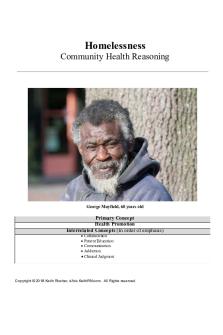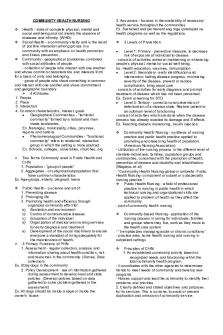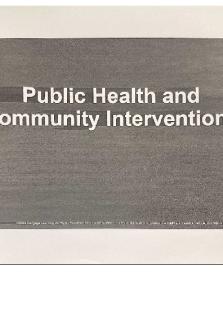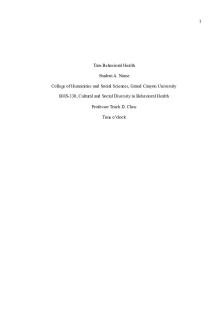Nurs 2014 community health PDF

| Title | Nurs 2014 community health |
|---|---|
| Author | Abby Murphy |
| Course | Comm Hlth Nurs Theory |
| Institution | Memorial University of Newfoundland |
| Pages | 41 |
| File Size | 803.2 KB |
| File Type | |
| Total Downloads | 46 |
| Total Views | 150 |
Summary
Entire course...
Description
NURS 2014 Community Health Nursing Concepts
Emily V. Walsh
1. Community: locality-based entity composed of systems of formal organizations; reflects society’s institutions, informal groups, and aggregates; components of community are interdependent; function is to meet a wide variety of collective needs. Dimensions of Community i. People: community population. ii. Place: geographic location. iii. Function: aims of the community. Types of Communities i. Geographic Communities o Face-to-Face Community (AKA: Neighbourhood Community) o Community of Identifiable Need (ex. rural NL needing a dialysis unit) ii. Common Interest o Community of Problem Ecology (ex. St. John’s Harbour “Bubble;” people who came together to get a filtering system) o Community of Concern (ex. sidewalk safety) o Community of Special Interest o Community of Viability (ex. people who suffered after the moratorium came together to make a new livelihood) o Community of Action Capability o Community of Political Jurisdiction (ex. a community lobbying for a resource; politicians usually involved) iii. Resource Community: a community with multiple resources (ex. St. John’s). iv. Community of Solution: group that pools together to find a solution to an adverse problem (ex. anti-bullying groups). v. Virtual Communities: online groups (ex. Facebook, Twitter, Instagram). 2. Public Health Milestones Milestones: i. 1601: Elizabethan Poor Law enacted (treats rich and poor fairly in healthcare) ii. 1737: Marguerite d’Youville founded the order of Grey Nuns; first group of nurses focused on caring for the sick in their homes and community hospitals in Quebec. iii. 1798: Marine Hospital Services established in the USA; later called Public Health Services iv. 1812: Sisters of Mercy established in Dublin, Ireland. v. 1860: Florence Nightingale Training School for Nurses established at St. Thomas Hospital in London, England. vi. 1864: American Red Cross founded. vii. 1874: William Rathbone and Florence Nightingale instituted district nursing in England. Cities were divided into districts, and nurses were assigned to geographic sections of the city and were responsible for the health of the people living in that section. viii. 1895: Canadian Red Cross founded. ix. 1845-1895: Grey Nuns expanded and founded community hospitals with home visits in Ottawa, Ontario, St. Boniface, Manitoba, Edmonton, Alberta, and Saskatoon, Saskatchewan. x. 1897: Lady Aberdeen establishes Victorian Order of Nurses (VON).
1
NURS 2014 Community Health Nursing Concepts
Emily V. Walsh
19th Century Groups of Nurses: hospital nurses, private duty nurses, public health (visiting) nurses, and nursing sisters/military nurses. Public Health Nursing Leaders i. Lillian Wald: American social reformer; invented public health nursing, established an American system of insurance payment for home based care (Metropolitan Life Insurance Company), and created an American public health nursing service. ii. Eunice Dyke: Canadian public health nursing pioneer; hired as first superintendent of PHN in Toronto’s department of public health in 1911. She was also the first person to write about what she carried in her nurse’s bag.
3. Community Health Nursing: registered nurses whose practice combines the knowledge of public health science, primary health care, nursing science, and the social sciences. Links the health and illness experiences of individuals, families, and communities to population health promotion practice, and recognizes that a community’s health is closely linked to the health of its members. Recognizes that health communities and systems that support health contribute to opportunities for health, and practices in increasingly diverse settings. Practice Areas i. Public Health Nurse (PHN): use knowledge of nursing, social sciences, and public health sciences for the promotion and protection of health and for the prevention of disease among populations. ii. Home Health Nurse (HHN): use their knowledge and skills to provide direct care and treatment for individuals to maintain and restore health or to provide palliation during illness. iii. Occupational Health Nurse (OHN): an RN who specializes in workplace health and safety, health promotion, disease prevention, and rehabilitation for workers. iv. Parish Nurse: an RN who serves the health and wellness needs to faith community members. v. Primary Health Care Nurse Practitioner: an RN with advanced practice education, which allows for an expanded role, such as diagnosing episodic illnesses, prescribing medication, and ordering diagnostic tests. vi. Outpost Nurse: an RN who works in an outpost or rural setting that is often geographically separated from face-to-face physician contact. vii. Forensic Nurse: an RN who has completed continuing education programs in the area of forensic science. Often in hospital emergency departments to deal with crime based illness and injury, such as sexual assault. viii. Telenurse: an RN who provides nursing service over the telephone. Population vs. Aggregate: a population is a large group of people who share one or more personal or environmental characteristic and live in a community (ex. school population); and aggregate is a subpopulation or a group within the population (ex. number of students in school who smoke). Roles of Community Health Nursing: there are six roles of community health nursing: i. Health Promotion ii. Disease and Injury Prevention o Primary Prevention: an intervention or activity that aims to prevent disease or illness from occurring.
2
NURS 2014 Community Health Nursing Concepts
Emily V. Walsh
Secondary Prevention: an intervention or activity that aims at early detection of the disease or illness before the symptoms become apparent. o Tertiary Prevention: interventions that aim at interrupting the course of a disease or to reduce the amount of disability resulting from the disease (ex. rehabilitation). iii. Health Protection iv. Health Surveillance: statistical analysis. v. Population Health Assessment vi. Emergency Preparedness and Response CHN Activities: community health nurses participate in a number of activities, including: o
-
Consultation Facilitation Health Education Health Threat Response Leadership Outreach Resource Management Planning and Coordination
-
Advocacy Building Capacity Building Coalition and Networks Care/Counselling Case Management Communication Community Development
Screening Surveillance Team Building and Collaboration Policy Development and Implementation Referral and Follow Up Research and Evaluation
4. Primary Health Care: essential health care that is based on practical, scientifically sound and acceptable methods and technology made universally accessible to individuals and families in the community through their full participation and at a cost that the community and country can afford to maintain at every stage of their development in the spirit of self reliance and self determination. Principles: the principle of primary health care are: Accessibility Intersectoral Cooperation Public Participation Appropriate Technology Health Promotion
PHC and CHN: provides essential health care services in the community; considers the determinants of health, and focuses on health promotion, disease prevention, and protection. Includes therapeutic, curative, and rehabilitative care; promotes coordination and interdisciplinary collaboration; and focuses on the client as an equal partner in health with health professionals.
5. Determinants of Health: there are 12 determinants of health: Income and Social Status Personal Health Practices and Social Support Networks Coping Skills Healthy Child Development Education and Literacy Biology and Genetics Employment and Working Conditions Health Services Social Environments Gender Physical Environments Culture
3
NURS 2014 Community Health Nursing Concepts
Emily V. Walsh
6. Empowerment: actively engaging the client to gain greater control and involves political efficacy, improved quality of community life, and social justice. 7. Canadian Community Health Nursing Standards: a published set of behavioral and professional expectations of certificate holders in community health nursing. Standards promote consistency and sets parameters as guidelines for CHNs. Types of Standards i. Provincial/Territorial Standards of Practice: defined and regulated by a provincial/territorial nursing association (ex. ARNNL). Legally required to be practiced by all RNs and is required upon entry into practice. ii. Specialty Standards of Practice: defined by a national nursing organization associated with the Canadian Nurses Association (CNA). Provides standards specific to the practice of community health nurses that are ‘technically’ voluntary. Requires a defined period of practice in the specialty area under supervision (ex. 2 years). *Specialty nurses must still continue to follow provincial/territorial standards in addition to specialty standards. iii. Organizational Standards (AKA: Mission, Mandate) iv. Unit Standards v. Client Standards Stages of the Use of the CCHN Standards i. Nursing Students: develop knowledge of the CCHN standards and learn how to apply the community health nursing process during a community placement. ii. New Registered Nurses in CHN: gain knowledge and experience in community health nursing by applying the CCHN standards in one or two practice settings. iii. CHN Nurses With 2+ Years Experience: reorient, confirm, and maintain CCHN standards across all aspects of practice. Development of the CCHN Standards: developed by a geographically representative committee of CHNs under the auspices of CHNAC (now called the CHNC – Community Health Nurses of Canada). Input was received from over 1000 CHNs across Canada. The process took over three years and was formally released in October 2003. It was reviewed in 2008 and 2011. Purpose of CCHN Standards: define the scope and depth of CHN practice; establish criteria or expectations for acceptable nursing practice and safe, ethical care; support the ongoing development of CHN; provide criteria for measuring actual performance; promote CHN as a specialty and provide the foundation for certification of CHN by CNA; inspire excellence and commitment to CHN practice; set a benchmark for new CHNs. How to Read a CCHN Standard: each standard is outlined in the following format: i. Overview: brief overall description of standard. ii. Indicators: provide the expected outcomes when the standard is applied to practice.
4
NURS 2014 Community Health Nursing Concepts
Emily V. Walsh
iii. Activities: define the activities that CHNs are expected to perform to achieve the indicators. iv. Examples: examples from CHN practice. v. Description: full description is provided. The CCHN Standards: note that standards 4-7 help us to achieve standards 1-3. i. Health Promotion: involves the population as a whole in the context of their everyday life rather than focusing only on at-risk people; the process of addressing health inequities and enabling people to increase control over and to improve their health; brings together people who recognize that basic resources and conditions for health are critical (i.e., determinants of health); works best when all levels and multiple approaches are used o Indicator Example: the CHN collaborates with individuals, families, groups, community populations, or systems to do comprehensive assessment of assets and needs, acknowledging that differences exist in different members of the population. ii. Prevention and Health Protection: the CHN applies a repertoire of activities to minimize the occurrence of diseases or injuries and their consequences; health protection strategies often become mandated programs and laws. o Indicator Example: the CHN participates in surveillance activities; analyzes and utilizes this data to identify and address health issues within a population or community. iii. Health Maintenance, Restoration, and Palliation: includes the full spectrum of acute, chronic, and palliative nursing care (HHNs), health teaching and counseling for health maintenance or dealing with acute, chronic, or terminal illness; links people to community resources and facilitates/coordinates care needs and supports. o Indicator Example: the CHN develops mutually agreed upon plans and priorities for care with the individual, family, group, community, population, or system. iv. Professional Relationships: built on the principles of connecting and caring; relationships may be with clients and/or with organizations/stakeholders; relationships built on mutual respect and on an understanding of the power inherent to the CHN position; unique to CHN is building a network of relationships and partnerships – occurs within a complex environment for both PHNs and HHNs. v. Capacity Building: capacity building describes an increase in ability of individuals/communities to define, assess, analyze, and act on health concerns; active involvement by those affected is critical; CHN works collaboratively with those affected by the health concern and those who control resources; CHNs assess the stage of readiness for change and priorities for action; CHNs build on existing strengths.
5
NURS 2014 Community Health Nursing Concepts
Emily V. Walsh
vi. Access and Equity: CHNs identify and facilitate universal and equitable access to services and resources; CHNs engage in advocacy on many levels including services appropriate for cultural groups in the community; CHNs collaborate with other services and sectors to promote effective working relationships that contribute to comprehensive client care and achievement of optimal outcomes. vii. Professional Responsibility and Accountability: CHNs work with a high degree of autonomy – accountable for their competence and quality of their practice; CHNs work in a complex environment with accountability to a variety of authorities; CHNs encounter unique ethical dilemmas. 8. A Healthy Community: communities that take a holistic and integrated approach to increasing health, wellbeing, and healthy development of the community and its members; a community were people, organizations, and local institutions work together to improve the social, economic, and environmental conditions that make people healthy as accomplished through community partnerships and coalitions. Measures of Community Health i. Status: measured by vital statistics, such as mortality/morbidity rates. May lead to primary and secondary interventions. ii. Structure: measured by health facilities, such as health units. Includes program development. iii. Process: measured by participation/management of relationship within society. Health promotion is critical. Healthy Communities Movement: international movement in 1980s promoting healthy communities developed in Europe; movement dedicated to widespread approach to health; involves national and local policy makers, grassroots individuals, agencies, and businesses in planning health programs. This is important because it deals with many determinants of health that are outside the scope of the healthcare system and implements policies that would provide greater access and equity, having a tremendous impact on health. Characteristics of Healthy Communities: i. Clean and safe physical environment ii. Peace, equity, and social justice iii. Adequate access to food, clean water, shelter, income, safety, work, and recreation for all iv. Strong, mutually supportive relationships and networks v. Wide participation of residents in decision making vi. Strong cultural and spiritual heritage vii. Diverse and robust economy viii. Opportunities for learning and skill development ix. Access to health services, including public health and preventative programs CHN Roles in Healthy Communities: identifying health issues in the community; helping community members investigate health issues, and then organize and present these
6
NURS 2014 Community Health Nursing Concepts
Emily V. Walsh
issues to the appropriate resource; lending their expertise to advocate specific issues; building coalitions with other sectors, such as education, housing, and recreation. Community as a Partner: when the CHN partners with community groups; blends professional knowledge with the community’s specific knowledge and resources; emphasizes the community’s strengths; epidemiological data are also considered, however, in relation to what is meaningful for the community. i. Partnership: conveys an egalitarian relationship between the nurse and the community, encouraging community involvement, autonomy, and empowerment. ii. Community as a Partner Model: based on Neuman’s 1972 Systems Model; developed by Anderson and McFarlane in 1986 to illustrate the synthesis of public health and nursing; has evolved to incorporate the philosophy that nurses work with communities as partners; assessment wheel is the heart of the model.
9. Community Assessment: the process of thinking critically about the community; involves getting to know and understand the community client as partner through a logical systematic approach in the initial phases of the community health nursing process. Community Assessment Steps: there are three basic steps: i. Data Collection: involves community participation and collaboration in all stages of assessment through evaluation; CHNs must have purposeful interaction with other professionals, most importantly with the community members; health issues are value-laden; only the community members know these values. There are seven key data-collection methods:
7
NURS 2014 Community Health Nursing Concepts o o
o
o
Emily V. Walsh
Secondary Analysis of Existing Data: previously gathered information; extremely valuable as it saves time (ex. Census databases). Participant Observation: can provide very good information about community norms, beliefs, values, power, influence structures, and problem solving; caution the use of intuition. a. Windshield Survey: involves studying data already available on the community to gain a working knowledge of the community; drive or walk around the community to find health, social/government services, obtain literature, introduce themselves as working in the community, and becoming familiar with the community. Surveys: report data from a sample of persons; telephone, interview, mail, or web-based; provides a broad range of data that are helpful when used in conjunction with other sources; time-consuming and costly as reliability and validity need to be determined. Focus Groups: similar to the community forum or town hall meeting
with some differences that are designed to obtain grassroot opinions; usually 5-15 people homogenous in regard to demographic variables; the interviewer guides the discussion according to a predetermined set of questions or topics. o Informant Interviews: selected members of a community whose views/ideas represent those of the community; not always those who have a formal role or title – they may have an informal role in the community (more common in smaller communities); critical to community assessment. ii. Composite Database Development: the gathering of data collected from all sources into one comprehensive database. iii. Interpreting the Database: your interpretation of the database must be presented to the members of the community (vital). This provides an opportunity for verification of the findings. Purpose of Community Assessment: assists the CHN to identify community strengths, resources, assets, capacities, and opportunities; clarify community needs (actual, potential) and health concerns; indentifies community constraints; identifies economic, political, and social factors; identifies determinants of health affecting...
Similar Free PDFs

Nurs 2014 community health
- 41 Pages

Community health final
- 14 Pages

Community Health Nursing RLE
- 15 Pages

Community Health Diagnosis
- 136 Pages

ATI Community Health Focus
- 24 Pages

ATI Community Health Study
- 22 Pages

Community Health Nursing Kaplan
- 41 Pages
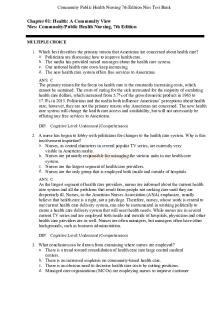
Community Health Test Bank
- 10 Pages

COMMUNITY HEALTH NURSING NOTES
- 2 Pages
Popular Institutions
- Tinajero National High School - Annex
- Politeknik Caltex Riau
- Yokohama City University
- SGT University
- University of Al-Qadisiyah
- Divine Word College of Vigan
- Techniek College Rotterdam
- Universidade de Santiago
- Universiti Teknologi MARA Cawangan Johor Kampus Pasir Gudang
- Poltekkes Kemenkes Yogyakarta
- Baguio City National High School
- Colegio san marcos
- preparatoria uno
- Centro de Bachillerato Tecnológico Industrial y de Servicios No. 107
- Dalian Maritime University
- Quang Trung Secondary School
- Colegio Tecnológico en Informática
- Corporación Regional de Educación Superior
- Grupo CEDVA
- Dar Al Uloom University
- Centro de Estudios Preuniversitarios de la Universidad Nacional de Ingeniería
- 上智大学
- Aakash International School, Nuna Majara
- San Felipe Neri Catholic School
- Kang Chiao International School - New Taipei City
- Misamis Occidental National High School
- Institución Educativa Escuela Normal Juan Ladrilleros
- Kolehiyo ng Pantukan
- Batanes State College
- Instituto Continental
- Sekolah Menengah Kejuruan Kesehatan Kaltara (Tarakan)
- Colegio de La Inmaculada Concepcion - Cebu

